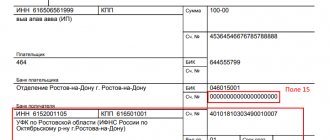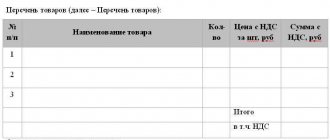Reasons for overpayment
Overpayment between counterparties can occur for a number of reasons:
- The simplest of situations. Due to an error by an accountant or other person responsible for transferring funds, more money was transferred to the supplier’s account than it should have been.
- If the supplier has delayed a delivery for which funds have already been transferred. If the agreement between organizations does not stipulate otherwise, then the recipient in this case may refuse to accept the goods altogether. This is clearly stated in Article 511 of the Civil Code of the Russian Federation, paragraph 3.
- Refusal by the buyer of a product due to its low quality (defects, etc.). If the supplier in this case has already been paid an advance, then an overpayment arises (Article 523 of the Civil Code of the Russian Federation).
- The agreement under which the funds were transferred was terminated by one of the parties. In this case, there is, of course, no talk of offset by future supplies or services.
Before drawing up a letter about the offset of the overpayment, you need to make sure that the calculations by the organization’s accounting department were made correctly. To do this, the supplier is asked to draw up a bilateral reconciliation report. This will allow you to reach a common opinion regarding the amount of the overpayment.
Application (petition) for offset
If the applicant changes his mind about contacting the government agency, and the specific details of the application (case number, full name of the defendant, etc.) were not indicated in the purpose of payment, an application for offset will not be required. The payment order can be used for 3 years.
If a state duty that is subject to refund from the budget is offset, for offset the payer must submit an application for offset of the state duty to the authorized body where he applies to perform a legally significant action.
The following must be attached to the application for set-off (when applying to the court, it can also be called a petition):
- for a court state fee - a decision or ruling in another case and a court certificate stating that the consideration of the case did not take place, and the state fee can be returned to the plaintiff or offset;
- payment order or original receipt confirming its payment.
An application for offset of state duty may be submitted by a representative of the payer. In this case, a copy of the power of attorney confirming the authority of the representative is attached to it.
Composition of the letter form
Typically, this kind of paper is printed on the organization’s letterhead. On their upper part are the company details. If a business letter is printed on a regular A4 sheet without notes, then at the very top you must indicate the name and basic information of the organization that is sending the message.
- Information about the addressee. Full name of the head of the supplier’s organization, his position, the name of the company itself.
- Document Number. It is needed for subsequent accounting and recording of outgoing documentation.
- Date of signing.
- Title of the paper.
- The amount of overpayment. It must be clearly known to both parties.
- To which account the payment was made (link with document number and date).
- What to do with the overpayment: return it or offset it against payment for subsequent deliveries (or provision of services). If there is information about the number and date of the account to which the overpayment should be credited, then it is indicated.
- Please offset the overpayment against future payments if a specific account number is not available.
- If necessary, the amount of VAT.
- Signature, position of the head, seal of the organization.
When is offset possible?
The basis for crediting the state duty will be clause 6 of Art. 333.40 of the Tax Code of the Russian Federation. According to this norm of legislation, a person who has paid an excess state fee has the right to offset it against the amount of state duty that must be paid for performing a similar action. Such a re-offset of state duty also does not contradict the norms of procedural codes (Arbitration Procedure Code of the Russian Federation, Civil Procedure Code of the Russian Federation, CAS of the Russian Federation).
Excess state duty may arise as a result of:
- its overpayment, that is, payment in a larger volume than required by law;
- payments using incorrect details;
- return of an application, appeal or complaint or refusal to accept it;
- if the court terminated the proceedings or left the application without consideration;
- if the applicant changes his mind about applying to the government agency;
- if a decision is made to cancel the court order, the state duty can be offset when filing a statement of claim on the same issue (clause 13, clause 1, article 333.20 of the Tax Code of the Russian Federation).
- on other grounds provided for in Art. 333.40 of the Tax Code of the Russian Federation.
Offset is possible only against the state duty payable for performing a similar action (that is, the state duty paid for filing a claim cannot be offset against the state duty for registering rights to real estate).
If a government body justifiably refused to perform a legally significant action (registration, issuance of a document, etc.), then when applying for a similar action again, the offset is impossible, the state fee must be paid again.
Expert opinion
Lawyer Alexander Vasiliev comments
Excessively paid state duty cannot be offset against tax arrears (Resolution of the Federal Antimonopoly Service of the Volga-Vyatka District dated February 15, 2013 No. A43-20114/2012).
Options for replying to a letter
The supplier may agree to the terms proposed in the letter, or may refuse them. Also, if you refuse, he will probably offer his own way out of the situation. For example, it will be much more convenient for the supplier’s accounting department (and more profitable for their manager) to transfer excess funds back than to transfer them towards future deliveries. The likelihood of such circumstances is especially increased by the lack of information on this point in the contract between organizations. Thus, the supplier may have to provide another letter requesting a refund of the overpaid funds.
What to do with VAT
If an incorrect payment (for goods not delivered, services not performed, etc.) was provided along with VAT, then the amount of this payment should be recalculated. The algorithm is as follows:
- If the advance invoice was issued by the supplier for an incorrect amount (one that was received in error or was exceeded), then it must be corrected. To do this, you need to send a letter to the supplier asking him to issue another advance invoice with the correct numbers.
- The supplier forwards a copy of the correct invoice.
- Then the entry in the organization’s purchase book is canceled. But this correction must be the exact number for which the correct invoice is issued.
- If the reporting quarter has expired, you will have to draw up an additional sheet for the purchase book, through which the marks on registered invoices are still corrected.
- The correct VAT is charged on the new invoice.
However, there is a fundamentally important nuance regarding the last point. The amount that was overpaid is, in fact, an advance payment for future delivery. However, VAT should not be taken from it until the shipment or provision of services. After all, the contract (referenced by the correct invoice) indicates a different contract number with the supplier. And before the transaction is actually completed, the deduction will be illegal.
In the letter about offset of the overpayment to the supplier, be sure to specify under which specific agreement the overpayment arose and in what amount.
At the same time, indicate what you expect from the seller. For example, so that he can offset other agreements. Provide the number and date of the contract to which you are asking to transfer the overpayment. It is better to put live signatures and stamps on the document, send it by mail or deliver it with a courier. There are no trifles in business correspondence.
What to do if there is an error in a payment order?
Are you familiar with the situation when you hastily issued a payment order for tax transfer, the bank executed the order, and subsequently you discovered an error in the KBK - what to do in this situation?
The solution is simple: you need to file an application with the tax office to clarify the payment. The Ministry of Finance also speaks about this in letter dated January 19, 2017 No. 03-02-07/1/2145.
The same should be done if an error is made in other fields of the payment order, such as:
- basis of payment;
- taxpayer status;
- tax payment period;
- OKTMO;
- number or date of the basis document;
- purpose of payment.
TIN and KPP of the sender or recipient;
IMPORTANT! Errors in the account number and in the name of the bank receiving the payment are irreparable (clause 4 of article 45 of the Tax Code of the Russian Federation). In this case, there is only one way out - send a new payment with the correct details, pay a fine and write to the Federal Tax Service an application for the return of the payment paid with incorrect details.
You can find your tax office details on the Federal Tax Service website. See here for details.
Let's look at the procedure for completing and a sample letter to clarify a payment to the tax office if the KBK is indicated incorrectly.
How long is the letter stored and where is it registered?
All business correspondence must go through the outgoing documentation journal. It notes the main content of the letter, its number and date. This way you can confirm the existence of the paper if legal proceedings are subsequently held on this issue.
As for the storage period, for letters of this kind it is 5 years.
This is due to the fact that it is directly related to the business relationship with the supplier of goods or services. When these documents, the letter of request and the letter are systematized, the response to it is classified as a single matter. This is the only way to reconstruct the entire course of the correspondence and study the arguments and demands of both sides subsequently.
Source of the article: https://assistentus.ru/forma/pismo-o-zachyote-pereplaty-postavshchiku/
vzaimozachet.jpg
Related publications
Business entities operating on the territory of the Russian Federation have the right to terminate the obligations of the parties using the methods specified in federal legislation. In practice, cash offsets are most often used. This procedure involves drawing up an appropriate agreement. Special conditions for mutual offset are given in Art. 410 of the Civil Code of the Russian Federation. The legislation also approved a list of situations when the use of this method is unacceptable (Article 411 of the Civil Code of the Russian Federation).
Cash Settlement Agreement
Organizations that have similar counterclaims to each other have the right to draw up an agreement on the offset of funds, a sample of which is presented below for informational purposes.
There is no officially approved agreement form, so it is drawn up in any form. The document should indicate all essential conditions regarding offset:
- the fact of an agreement reached;
- a list of agreements under which it was carried out.
The agreement is drawn up in two identical copies.
The head of the organization can independently draw up a letter about the offset of funds and an agreement, or entrust this to a staff lawyer or a specialist from the structural unit who is in charge of the agreements under which the offset was carried out. The person responsible for drawing up documents must have an understanding of all the details of contractual obligations and the rules for drawing up such documents. Read our article about how to take into account netting transactions in accounting. And here you will find a sample act for offsetting mutual claims.
Source of the article: https://spmag.ru/articles/soglashenie-o-zachete-denezhnyh-sredstv-obrazec
Refund/refund of funds
A refund:
To return funds for canceled applications and resulting overpayments (decrease in cost, claim, etc.), the client must contact the Tour Operator’s accounting department with a written application (Appendix No. 1 for legal entities and individual entrepreneurs, Appendix No. 2 for individuals). The application is sent by email with the obligatory indication in the subject line: “Application for return (indicate the application number!)” Example: “Application for return SSH 50125 SM ” , or sent by mail to the address: 107045, Moscow, Yuzhnoportovaya st. , 5 building 7, 3rd floor. The following documents are attached to the application:
- a copy of the payment order confirming payment from the current account of the client (legal entity),
- payment terminal receipts (individuals),
- payment receipts (individuals);
- booking/cancellation confirmation;
- application for cash refund (individual);
- a copy of the passport of a citizen of the Russian Federation (individual);
- in case of a refund based on a claim - a copy of the response from the Tour Operator’s legal department to the claim.
How can an accountant write a competent letter to a counterparty?
A properly structured dialogue with the counterparty will help save money, effort and time. Therefore, it is a good idea to have a few sample letters on hand.
Letter on the procedure for settlements under the agreement
In practice, if errors occur in payments, it is usually in payments under different agreements. However, confusion can also arise in settlements under one contract. Most often this happens if a framework agreement is concluded between the seller and the buyer. Under such agreements, goods may be paid for periodically on the basis of individual applications or agreements. And the buyer may forget to indicate in the payment slip exactly which delivery he is paying for, or mix up the invoices. All this threatens to result in a dispute about what the payment document confirms: the transfer of an advance payment towards a future delivery or payment for goods already delivered.
To avoid such disputes, the agreement must stipulate the procedure for offsetting payments in the event of ambiguities in payment invoices. If the agreement does not contain such a condition, write a letter to the counterparty explaining the procedure by which you will set off payments. A written response from the counterparty with consent will mean that you have agreed on the settlement procedure.
Agreement on Set-off of Mutual Claims
A set-off agreement is useful when you and your counterparty have mutual debts. In order to be able to conduct an offset, certain conditions must be met:
• counterclaims must be homogeneous. For example, the parties owe each other money. One has a debt for services rendered to her, and the second has a debt for a loan;
•the deadline for fulfilling each of the requirements must have arrived at the time of offset;
•the offset must not contradict the requirements of the law or contract. For example, you cannot set off a claim for which the statute of limitations has expired.
For offset, a statement from one party is sufficient. From the moment the other party receives the application, the offset is considered completed.
But the fact of receipt of such an application must be confirmed documentaryly (for example, a notification of delivery, a receipt) clause 4 of the Information Letter of the Presidium of the Supreme Arbitration Court dated December 29, 2001 No. 65. Therefore, in order to avoid possible disputes, it is better to draw up a bilateral agreement on offset.
Please transfer money to another company's account
It happens that an organization, due to some circumstances, is not able to pay under the contract itself. For example, when the account is blocked by decision of the Federal Tax Service or there is simply no money on it. In this situation, you can ask your debtor to pay for you. Such an operation is not contrary to the law. And the creditor is obliged to accept payment.
The Civil Code does not regulate what documents should be used to document payment of a debt by a third party. Typically, the debtor company (let's call it company A) sends a letter to a third party (company B) asking it to pay its debt to the creditor (company C). And company B, when transferring money to company C, indicates in the payment order that it is paying for company A. A letter with a request to fulfill the obligation and a note in the payment order will serve as evidence that the money was transferred specifically to repay the debt of company A.
But before you ask the debtor for payment, carefully review the agreement with your creditor. Perhaps it prohibits payment by third parties. In this case, you will have to pay yourself. And if a third party transfers the money, the lender will return it. And if the payment deadline is missed, you may face sanctions.
Claim
The claim is needed to comply with the mandatory pre-trial settlement procedure for certain categories of disputes. In particular, regarding requests for payment of funds. If the pre-trial procedure is not followed, the court will leave the claim without consideration or return it.
Contracting parties who have been at fault usually take claims seriously. After all, such a letter means that after 30 calendar days you can go to court. This period is counted from the date of filing the claim, unless a different period is established by the contract.
The claim must indicate the details of the contract, invoices (acts of work performed or services rendered), the amount of debt and penalties, their calculation, as well as the procedure and period for repaying the debt.
Payment clarification letter
Payment errors are not uncommon, and often they are not so harmless. For example, an accountant may confuse the contract number in the payment purpose and indicate the one under which the goods were not supplied. In this situation, there is a risk that tax authorities will regard such a payment as an advance under a new contract and charge VAT to the seller. Or the seller, having received an advance payment, will not supply the goods because the contract number in the payment order is incorrect. All this can be corrected by writing a letter to the seller about changing the purpose of payment.
If the seller agrees to the payment change, send notice of the change in payment purpose to your bank. The notification must be signed by the same persons who signed the payment. Attach copies of the payment order and written consent of the recipient to the notification.
This is not a complete list of letters that may be needed in your work. On our website you can find others, for example, a notification of a change of legal address on the Civil Code website or a letter about a change in bank details on the Civil Code website.
Source of the article: https://zen.yandex.ru/media/glavkniga.ru/kak-buhgalteru-sostavit-gramotnoe-pismo-kontragentu-5b9f9260990e6000aa9058f2
How can I get my money back?
The legislation of the Russian Federation, which regulates problems of enforcement, gives bailiffs the right to seize the debtor’s account, but not just any account.
There are a number of prohibitions. However, bailiffs are not able to accurately determine which accounts are allowed to be seized and which are not. After lengthy disputes between citizens and bailiffs, finally 2 years ago changes were made to the legislation that provided clarification of the circumstances under which bailiffs do not have the right to seize certain accounts.
Borrowers against whom enforcement proceedings have been opened are required to send the bailiffs themselves documents confirming which accounts cannot be seized.
When opening an enforcement case, the bailiff is obliged to draw up an act that is sent to the debtor.
The person who received such a notification must, within 5 days, either carry out the proceedings or provide materials proving which accounts cannot be seized.
If money is suddenly written off from an account not intended for this, you must immediately file a statement with the bailiff who carried out the collection.
The application is drawn up according to the rules inherent in business official rules, preserving its structure, information about each party, describing the essence of the problem that has arisen and the requirements. Like any application, the letter must be signed indicating the date of preparation. This document will be the basis for the bailiff to cancel a previously issued order to seize the account.
There is no time limit for returning money. However, Law No. 229-FZ defines the time for the return of the enforcement fee as 30 days from the moment the bailiff receives the request of the person from whom the money was wrongfully debited. If this time limit for returning an incorrectly collected fee is violated, no interest will be charged.
At the same time, the Civil Code of the Russian Federation states that the return of funds must be carried out within a week.
Due to the different interpretations in different legislative acts of the provisions on the return of illegally written off funds, Part 14.1 of Law N 229-FZ was introduced, which reflects the following:
When writing off money from the debtor's account in a larger amount than is required to pay off the debts, the return of the excess money written off from the deposit account of the bailiffs is carried out in accordance with Part 11 of Art. 70 of State Law No. 229-FZ of October 2, 2007.
Clause 12 of the Instructions on accounting for funds that are credited for temporary use by departments of bailiffs, adopted by Order of the Ministry of Justice of the Russian Federation No. 11, Ministry of Finance of the Russian Federation No. 15n dated January 25, 2008, the return of illegally written off amounts by bailiffs is carried out by decision of the senior bailiff.
Considering that the legislation does not clearly define the procedure for returning unlawfully collected amounts, and bailiffs may ignore a submitted application for the return of funds, it will be necessary to apply to the courts with a lawsuit.
Before writing a statement of claim, it is recommended to send a claim to the bailiff.










